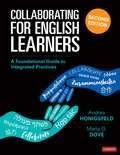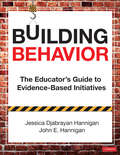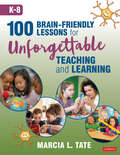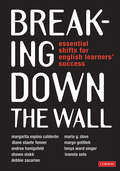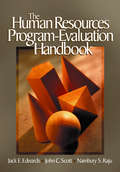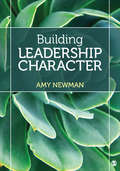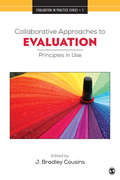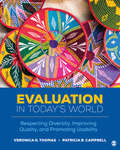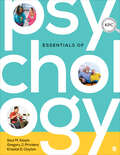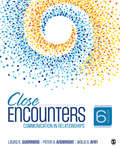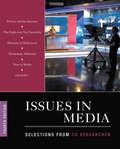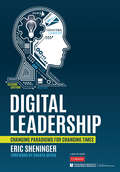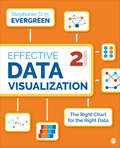- Table View
- List View
Collaborating for English Learners: A Foundational Guide to Integrated Practices
by Maria G. Dove Andrea HonigsfeldLooking for a silver bullet to accelerate EL achievement? There is none. But this, we promise: when EL specialists and general ed teachers pool their expertise, your ELs’ language development and content mastery will improve exponentially. Just ask the tens of thousands of Collaboration and Co-Teaching users and now, a new generation of educators, thanks to this all-new second edition: Collaborating for English Learners. Why this new edition? Because more than a decade of implementation has generated for Andrea Honigsfeld and Maria Dove new insight into what exemplary teacher collaboration looks like, which essential frameworks must be established, and how integrated approaches to ELD services benefit all stakeholders. Essentially a roadmap to the many different ways we can all work together, this second edition of Collaborating for English Learners features: All-new examples, case studies, illustrative video, and policy updates In-depth coverage of the full range of strategies and configurations for determining the best model to adopt Templates, planning guides, and other practical tools to put collaboration into practice Guidelines, self-assessments, and questionnaires for evaluating the strategies’ effectiveness By this time, the big benefits of teacher collaboration are well documented. Where teachers and schools struggle still is determining the best way to do so, especially when working with our ELs. That’s where Andrea Honigsfeld, Maria Dove, and their second edition of Collaborating for English Learners will prove absolutely indispensable. After all, there are no two better authorities.
Collaborating for English Learners: A Foundational Guide to Integrated Practices
by Maria G. Dove Andrea HonigsfeldLooking for a silver bullet to accelerate EL achievement? There is none. But this, we promise: when EL specialists and general ed teachers pool their expertise, your ELs’ language development and content mastery will improve exponentially. Just ask the tens of thousands of Collaboration and Co-Teaching users and now, a new generation of educators, thanks to this all-new second edition: Collaborating for English Learners. Why this new edition? Because more than a decade of implementation has generated for Andrea Honigsfeld and Maria Dove new insight into what exemplary teacher collaboration looks like, which essential frameworks must be established, and how integrated approaches to ELD services benefit all stakeholders. Essentially a roadmap to the many different ways we can all work together, this second edition of Collaborating for English Learners features: All-new examples, case studies, illustrative video, and policy updates In-depth coverage of the full range of strategies and configurations for determining the best model to adopt Templates, planning guides, and other practical tools to put collaboration into practice Guidelines, self-assessments, and questionnaires for evaluating the strategies’ effectiveness By this time, the big benefits of teacher collaboration are well documented. Where teachers and schools struggle still is determining the best way to do so, especially when working with our ELs. That’s where Andrea Honigsfeld, Maria Dove, and their second edition of Collaborating for English Learners will prove absolutely indispensable. After all, there are no two better authorities.
Building Behavior: The Educator′s Guide to Evidence-Based Initiatives
by John E. Hannigan Jessica Djabrayan HanniganBuild the behavior system your students need and deserve Students deserve a safe, welcoming, and tolerant learning environment in which high expectations for academic and social/emotional learning will flourish. To achieve this, schools must implement consistent behavior initiatives that are rooted in equity and clear in outcome and purpose. Which plan is best for your students’ needs? In Building Behavior, authors Jessica Djabrayan Hannigan and John Hannigan identify the strengths of six major research-based behavior initiatives and offer practical guidance for implementing one or more that meet the unique needs of your students and school. They explore and connect the relationship of effect sizes and influence of six common behavior initiatives—Positive Behavior Interventions and Supports, Character Education, Restorative Justice, Culturally Responsive Teaching, Trauma Informed Practices, and Social and Emotional Learning—to help educators understand the purpose of each and give school leaders a starting point for adding to, refining, or building a tailored behavior system that is effective and manageable. Building Behavior includes: Common definitions, frameworks, best practice resources, and tips for implementing and synthesizing each of the behavior initiatives Reflective prompts that connect the existing body of knowledge with real life experiences and practices Reproducible resources, including sample schoolwide and district-wide assessments Tips to avoid common implementation challenges and missteps Don’t just reach for the "next best thing." Learn to select, self-assess, and build a plan for effective implementation of a behavior system that meets the diverse academic and social/emotional learning needs of your students. "This book offers comprehensive, unbiased information on effective behavior initiatives and provides effective tools for implementing the action plan that best fits a school. It provides a one-stop shop that educators can use to evaluate their current behavior plan, research the most current behavior initiatives, and tailor-fit an initiative for their school." - Mandy White, Science Teacher, Vicenza Middle School, U.S. Department of Defense Education Activity
Building Behavior: The Educator′s Guide to Evidence-Based Initiatives
by John E. Hannigan Jessica Djabrayan HanniganBuild the behavior system your students need and deserve Students deserve a safe, welcoming, and tolerant learning environment in which high expectations for academic and social/emotional learning will flourish. To achieve this, schools must implement consistent behavior initiatives that are rooted in equity and clear in outcome and purpose. Which plan is best for your students’ needs? In Building Behavior, authors Jessica Djabrayan Hannigan and John Hannigan identify the strengths of six major research-based behavior initiatives and offer practical guidance for implementing one or more that meet the unique needs of your students and school. They explore and connect the relationship of effect sizes and influence of six common behavior initiatives—Positive Behavior Interventions and Supports, Character Education, Restorative Justice, Culturally Responsive Teaching, Trauma Informed Practices, and Social and Emotional Learning—to help educators understand the purpose of each and give school leaders a starting point for adding to, refining, or building a tailored behavior system that is effective and manageable. Building Behavior includes: Common definitions, frameworks, best practice resources, and tips for implementing and synthesizing each of the behavior initiatives Reflective prompts that connect the existing body of knowledge with real life experiences and practices Reproducible resources, including sample schoolwide and district-wide assessments Tips to avoid common implementation challenges and missteps Don’t just reach for the "next best thing." Learn to select, self-assess, and build a plan for effective implementation of a behavior system that meets the diverse academic and social/emotional learning needs of your students. "This book offers comprehensive, unbiased information on effective behavior initiatives and provides effective tools for implementing the action plan that best fits a school. It provides a one-stop shop that educators can use to evaluate their current behavior plan, research the most current behavior initiatives, and tailor-fit an initiative for their school." - Mandy White, Science Teacher, Vicenza Middle School, U.S. Department of Defense Education Activity
100 Brain-Friendly Lessons for Unforgettable Teaching and Learning (K-8)
by Marcia L. TateUse research- and brain-based teaching to engage students and maximize learning Lessons should be memorable and engaging. When they are, student achievement increases, behavior problems decrease, and teaching and learning are fun! In 100 Brain-Friendly Lessons for Unforgettable Teaching and Learning K-8, best-selling author and renowned educator and consultant Marcia Tate takes her bestselling Worksheets Don’t Grow Dendrites one step further by providing teachers with ready-to-use lesson plans that take advantage of the way that students really learn. Readers will find 100 cross-curricular sample lessons from each of the four major content areas: English/language arts, mathematics, science, and social studies. Plans designed around the most frequently taught objectives found in national and international curricula. Lessons educators can immediately replicate in their own classrooms or use to develop their own. 20 brain-compatible, research-based instructional strategies that work for all learners. Five questions that teachers should ask and answer when planning brain-compatible lessons and an in-depth explanation of each of the questions. Guidance on building relationships with students that enable them to learn at optimal levels. It is a wonderful time to be a teacher! This hands-on resource will show you how to use what we know about educational neuroscience to transform your classroom into a place where success if accessible for all.
100 Brain-Friendly Lessons for Unforgettable Teaching and Learning (K-8)
by Marcia L. TateUse research- and brain-based teaching to engage students and maximize learning Lessons should be memorable and engaging. When they are, student achievement increases, behavior problems decrease, and teaching and learning are fun! In 100 Brain-Friendly Lessons for Unforgettable Teaching and Learning K-8, best-selling author and renowned educator and consultant Marcia Tate takes her bestselling Worksheets Don’t Grow Dendrites one step further by providing teachers with ready-to-use lesson plans that take advantage of the way that students really learn. Readers will find 100 cross-curricular sample lessons from each of the four major content areas: English/language arts, mathematics, science, and social studies. Plans designed around the most frequently taught objectives found in national and international curricula. Lessons educators can immediately replicate in their own classrooms or use to develop their own. 20 brain-compatible, research-based instructional strategies that work for all learners. Five questions that teachers should ask and answer when planning brain-compatible lessons and an in-depth explanation of each of the questions. Guidance on building relationships with students that enable them to learn at optimal levels. It is a wonderful time to be a teacher! This hands-on resource will show you how to use what we know about educational neuroscience to transform your classroom into a place where success if accessible for all.
Breaking Down the Wall: Essential Shifts for English Learners’ Success
by Debbie Zacarian Maria G. Dove Margarita Espino Calderon Diane Staehr Fenner Tonya W. Singer Margo Gottlieb Ivannia Soto Shawn M. Sinclair-Slakk Andrea HonigsfeldIt was a dark and stormy night in Santa Barbara. January 19, 2017. The next day’s inauguration drumroll played on the evening news. Huddled around a table were nine Corwin authors and their publisher, who together have devoted their careers to equity in education. They couldn’t change the weather, they couldn’t heal a fractured country, but they did have the power to put their collective wisdom about EL education upon the page to ensure our multilingual learners reach their highest potential. Proudly, we introduce you now to the fruit of that effort: Breaking Down the Wall: Essential Shifts for English Learners’ Success. In this first-of-a-kind collaboration, teachers and leaders, whether in small towns or large urban centers, finally have both the research and the practical strategies to take those first steps toward excellence in educating our culturally and linguistically diverse children. It’s a book to be celebrated because it means we can throw away the dark glasses of deficit-based approaches and see children who come to school speaking a different home language for what they really are: learners with tremendous assets. The authors’ contributions are arranged in nine chapters that become nine tenets for teachers and administrators to use as calls to actions in their own efforts to realize our English learners’ potential: 1. From Deficit-Based to Asset-Based 2. From Compliance to Excellence 3. From Watering Down to Challenging 4. From Isolation to Collaboration 5. From Silence to Conversation 6. From Language to Language, Literacy, and Content 7. From Assessment of Learning to Assessment for and as Learning 8. From Monolingualism to Multilingualism 9. From Nobody Cares to Everyone/Every Community Cares Read this book; the chapters speak to one another, a melodic echo of expertise, classroom vignettes, and steps to take. To shift the status quo is neither fast nor easy, but there is a clear process, and it’s laid out here in Breaking Down the Wall. To distill it into a single line would go something like this: if we can assume mutual ownership, if we can connect instruction to all children’s personal, social, cultural, and linguistic identities, then all students will achieve.
Breaking Down the Wall: Essential Shifts for English Learners’ Success
by Debbie Zacarian Maria G. Dove Margarita Espino Calderon Diane Staehr Fenner Tonya W. Singer Margo Gottlieb Ivannia Soto Shawn M. Sinclair-Slakk Andrea HonigsfeldIt was a dark and stormy night in Santa Barbara. January 19, 2017. The next day’s inauguration drumroll played on the evening news. Huddled around a table were nine Corwin authors and their publisher, who together have devoted their careers to equity in education. They couldn’t change the weather, they couldn’t heal a fractured country, but they did have the power to put their collective wisdom about EL education upon the page to ensure our multilingual learners reach their highest potential. Proudly, we introduce you now to the fruit of that effort: Breaking Down the Wall: Essential Shifts for English Learners’ Success. In this first-of-a-kind collaboration, teachers and leaders, whether in small towns or large urban centers, finally have both the research and the practical strategies to take those first steps toward excellence in educating our culturally and linguistically diverse children. It’s a book to be celebrated because it means we can throw away the dark glasses of deficit-based approaches and see children who come to school speaking a different home language for what they really are: learners with tremendous assets. The authors’ contributions are arranged in nine chapters that become nine tenets for teachers and administrators to use as calls to actions in their own efforts to realize our English learners’ potential: 1. From Deficit-Based to Asset-Based 2. From Compliance to Excellence 3. From Watering Down to Challenging 4. From Isolation to Collaboration 5. From Silence to Conversation 6. From Language to Language, Literacy, and Content 7. From Assessment of Learning to Assessment for and as Learning 8. From Monolingualism to Multilingualism 9. From Nobody Cares to Everyone/Every Community Cares Read this book; the chapters speak to one another, a melodic echo of expertise, classroom vignettes, and steps to take. To shift the status quo is neither fast nor easy, but there is a clear process, and it’s laid out here in Breaking Down the Wall. To distill it into a single line would go something like this: if we can assume mutual ownership, if we can connect instruction to all children’s personal, social, cultural, and linguistic identities, then all students will achieve.
The Human Resources Program-Evaluation Handbook
by John C. Scott Nambury S. Raju Jack E. EdwardsTechnological advances and rapid changes in workforce demographics pose extensive challenges to human resources program evaluators. But little has been done to document successful human resources program assessment and implementation strategies. The Human Resources Program-Evaluation Handbook is the first book to present state-of-the-art procedures for evaluating and improving human resources programs. Editors Jack E. Edwards, John C. Scott, and Nambury S. Raju provide a user-friendly yet scientifically rigorous "how to" guide to organizational program-evaluation. Integrating perspectives from a variety of human resources and organizational behavior programs, a wide array of contributing professors, consultants, and governmental personnel successfully link scientific information to practical application. Offering authoritative guidance to both novice and experienced program evaluators, this unique guidebook includes New perspectives on organizational program-evaluation Methods to assess the efficiency of human resources programs Identification of potential pitfalls Real-life examples Additional references for program-evaluation best practices The Human Resources Program-Evaluation Handbook provide program-evaluation teams with content-specific guidance. Supplying useful and accurate evaluation techniques, the editors present a manual for enhancing the effectiveness and efficiency of most major types of human resources programs. Designed for academics and graduate students in industrial-organizational psychology, human resources management, and business, the handbook is also an essential resource for human resources professionals, consultants, and policy makers.
Building Leadership Character: Lessons In Authenticity And Credibility
by Amy NewmanExtending beyond traditional leadership books to offer readers a path for developing their own character, this compelling new text uses a storytelling approach and real-world cases to explore different dimensions of leadership character. With a clear, student-friendly writing style, bestselling author Amy Newman deftly captures various approaches in which corporations and people respond to situations in difficult times and learn from mistakes. Using real companies and situations, each chapter examines a leadership character dimension such as accountability, integrity, authenticity, and courage. Readers will learn to develop their own character, emotional intelligence, and leadership skills as they engage with assessments, reflection opportunities, and exercises.
Building Leadership Character: Lessons In Authenticity And Credibility
by Amy NewmanExtending beyond traditional leadership books to offer readers a path for developing their own character, this compelling new text uses a storytelling approach and real-world cases to explore different dimensions of leadership character. With a clear, student-friendly writing style, bestselling author Amy Newman deftly captures various approaches in which corporations and people respond to situations in difficult times and learn from mistakes. Using real companies and situations, each chapter examines a leadership character dimension such as accountability, integrity, authenticity, and courage. Readers will learn to develop their own character, emotional intelligence, and leadership skills as they engage with assessments, reflection opportunities, and exercises.
Collaborative Approaches to Evaluation: Principles in Use (Evaluation in Practice Series #3)
by J. Bradley CousinsEditor J. Bradley Cousins and colleagues meet the needs of evaluators seeking to implement collaborative and participatory approaches to evaluation in Collaborative Approaches to Evaluation: Principles in Use. Using a multi-phase empirical process to develop and validate a set of principles to guide collaborative approaches to evaluation, the book outlines the principles that the team developed, and then provides case studies of how these principles have been applied in practice. The case studies draw on programs globally in education, health, and community development. The book is an invaluable supplementary text for program evaluation courses where students’ projects are focused on more collaborative and participatory approaches, and it is an essential resource for practicing evaluators and those who commission program evaluations.
Collaborative Approaches to Evaluation: Principles in Use (Evaluation in Practice Series #3)
by J. Bradley CousinsEditor J. Bradley Cousins and colleagues meet the needs of evaluators seeking to implement collaborative and participatory approaches to evaluation in Collaborative Approaches to Evaluation: Principles in Use. Using a multi-phase empirical process to develop and validate a set of principles to guide collaborative approaches to evaluation, the book outlines the principles that the team developed, and then provides case studies of how these principles have been applied in practice. The case studies draw on programs globally in education, health, and community development. The book is an invaluable supplementary text for program evaluation courses where students’ projects are focused on more collaborative and participatory approaches, and it is an essential resource for practicing evaluators and those who commission program evaluations.
Evaluation in Today’s World: Respecting Diversity, Improving Quality, and Promoting Usability
by Veronica G. Thomas Patricia B. CampbellRecipient of a 2021 Most Promising New Textbook Award from the Textbook & Academic Authors Association (TAA) Evaluation in Today’s World: Respecting Diversity, Improving Quality, and Promoting Usability is a timely and comprehensive textbook that guides students, practitioners, and users of evaluations in understanding evaluation purposes, theories, methodologies, and challenges within today’s sociocultural and political context. Veronica G. Thomas and Patricia B. Campbell include discussions of evaluation history, frameworks, models, types, planning, and methods, through a social justice, diversity, and inclusive lens. The authors focus on ethics in diverse cultural contexts, help readers understand how social problems and programs get politicized and, sometimes, framed through a racialized lens, show how to engage stakeholders in the evaluation process, and communicate results in culturally appropriate ways. Included with this title: The password-protected Instructor Resource Site (formally known as SAGE Edge) offers access to all text-specific resources, including a test bank and editable, chapter-specific PowerPoint® slides.
Evaluation in Today’s World: Respecting Diversity, Improving Quality, and Promoting Usability
by Veronica G. Thomas Patricia B. CampbellRecipient of a 2021 Most Promising New Textbook Award from the Textbook & Academic Authors Association (TAA) Evaluation in Today’s World: Respecting Diversity, Improving Quality, and Promoting Usability is a timely and comprehensive textbook that guides students, practitioners, and users of evaluations in understanding evaluation purposes, theories, methodologies, and challenges within today’s sociocultural and political context. Veronica G. Thomas and Patricia B. Campbell include discussions of evaluation history, frameworks, models, types, planning, and methods, through a social justice, diversity, and inclusive lens. The authors focus on ethics in diverse cultural contexts, help readers understand how social problems and programs get politicized and, sometimes, framed through a racialized lens, show how to engage stakeholders in the evaluation process, and communicate results in culturally appropriate ways. Included with this title: The password-protected Instructor Resource Site (formally known as SAGE Edge) offers access to all text-specific resources, including a test bank and editable, chapter-specific PowerPoint® slides.
Essentials of Psychology
by Saul Kassin Gregory J. Privitera Krisstal D. ClaytonPsychology exists all around us. It influences politics, policy, social interactions, teaching and learning science, and even workplace practices. In Essentials of Psychology, authors Saul Kassin, Gregory J. Privitera, and Krisstal D. Clayton propel students into a clear, vibrant understanding of psychological science with an integrative, learn-by-doing approach. Students assume the role of a psychologist, carrying out experiments; and making predictions. Compelling storytelling, real-life examples, and the authors’ active practice approach encourages critical thinking and engagement. This title is accompanied by a complete teaching and learning package, including: Digital Option / Courseware SAGE Vantage is an intuitive digital platform that delivers this text’s content and course materials in a learning experience that offers auto-graded assignments and interactive multimedia tools, all carefully designed to ignite student engagement and drive critical thinking. Built with you and your students in mind, it offers simple course set-up and enables students to better prepare for class.
Essentials of Psychology
by Saul Kassin Gregory J. Privitera Krisstal D. ClaytonPsychology exists all around us. It influences politics, policy, social interactions, teaching and learning science, and even workplace practices. In Essentials of Psychology, authors Saul Kassin, Gregory J. Privitera, and Krisstal D. Clayton propel students into a clear, vibrant understanding of psychological science with an integrative, learn-by-doing approach. Students assume the role of a psychologist, carrying out experiments; and making predictions. Compelling storytelling, real-life examples, and the authors’ active practice approach encourages critical thinking and engagement. This title is accompanied by a complete teaching and learning package, including: Digital Option / Courseware SAGE Vantage is an intuitive digital platform that delivers this text’s content and course materials in a learning experience that offers auto-graded assignments and interactive multimedia tools, all carefully designed to ignite student engagement and drive critical thinking. Built with you and your students in mind, it offers simple course set-up and enables students to better prepare for class.
Close Encounters: Communication in Relationships
by Peter A. Andersen Laura K. Guerrero Walid AfifiClose Encounters: Communication in Relationships helps students learn about their own relationships with romantic partners, friends, and family members by focusing on issues that are central to describing and understanding close relationships. Best-selling authors Laura K. Guerrero, Peter A. Andersen, and Walid A. Afifi present research-based insights and content illustrated with engaging scenarios to show how state-of-the-art research and theory can be applied to specific issues within relationships. The updated Sixth Edition includes fresh content reflecting current research and trends in relationships, balanced with coverage of classic research, and continues to empower readers to be more critical consumers of information about relationships.
Close Encounters: Communication in Relationships
by Peter A. Andersen Laura K. Guerrero Walid AfifiClose Encounters: Communication in Relationships helps students learn about their own relationships with romantic partners, friends, and family members by focusing on issues that are central to describing and understanding close relationships. Best-selling authors Laura K. Guerrero, Peter A. Andersen, and Walid A. Afifi present research-based insights and content illustrated with engaging scenarios to show how state-of-the-art research and theory can be applied to specific issues within relationships. The updated Sixth Edition includes fresh content reflecting current research and trends in relationships, balanced with coverage of classic research, and continues to empower readers to be more critical consumers of information about relationships.
Issues in Media: Selections from CQ Researcher
by CQ ResearcherWhat is the future of television? Do social media and big data threaten privacy rights? Do children have too much access to violent media content? Is reporting on global conflict worth the risk? These questions—and many more—are at the heart of today’s media landscape. Written by award-winning CQ Researcher journalists, this collection of non-partisan reports focuses on fifteen hot-button issues impacting the media. With reports ranging from the fight over net neutrality to social media and politics, Issues in Media promotes in-depth discussion, facilitates further research, and helps readers formulate their own positions on crucial issues. And because it’s CQ Researcher, the reports are expertly researched and written, presenting readers with all sides of an issue. Key Features: Chapters follow a consistent organization, beginning with a summary of the issue, then exploring a number of key questions around the issue, next offering background to put the issue into current context, and concluding with a look ahead. A pro/con debate box in every chapter offer readers the opportunity to critically analyze and discuss the issues by exploring a debate between two experts in the field. All issues include a chronology, a bibliography, photos, charts, and figures to offer readers a more complete picture of the issue at hand.
Issues in Media: Selections from CQ Researcher
by CQ ResearcherWhat is the future of television? Do social media and big data threaten privacy rights? Do children have too much access to violent media content? Is reporting on global conflict worth the risk? These questions—and many more—are at the heart of today’s media landscape. Written by award-winning CQ Researcher journalists, this collection of non-partisan reports focuses on fifteen hot-button issues impacting the media. With reports ranging from the fight over net neutrality to social media and politics, Issues in Media promotes in-depth discussion, facilitates further research, and helps readers formulate their own positions on crucial issues. And because it’s CQ Researcher, the reports are expertly researched and written, presenting readers with all sides of an issue. Key Features: Chapters follow a consistent organization, beginning with a summary of the issue, then exploring a number of key questions around the issue, next offering background to put the issue into current context, and concluding with a look ahead. A pro/con debate box in every chapter offer readers the opportunity to critically analyze and discuss the issues by exploring a debate between two experts in the field. All issues include a chronology, a bibliography, photos, charts, and figures to offer readers a more complete picture of the issue at hand.
Digital Leadership: Changing Paradigms for Changing Times
by Eric C. SheningerLead for efficacy in these disruptive times! Just as the digital landscape is constantly evolving, the second edition of Digital Leadership moves past trends and fads to focus on the essence of leading innovative change in education now and in the future. As society and technology evolve at what seems a dizzying pace, the demands on leaders are changing as well. With a greater emphasis on leadership dispositions, this revamped edition also features New structure and organization emphasizing the interconnectivity of the Pillars of Digital Leadership to drive sustainable change Innovative strategies and leadership practices that enhance school culture and drive learning improvement Updated vignettes from digital leaders who have successfully implemented the included strategies New online resources, informative graphics, and end of chapter guiding questions Now is the time to embrace innovation, technology, and flexibility to create a learning culture that provides students with 21st century critical competencies!
Digital Leadership: Changing Paradigms for Changing Times
by Eric C. SheningerLead for efficacy in these disruptive times! Just as the digital landscape is constantly evolving, the second edition of Digital Leadership moves past trends and fads to focus on the essence of leading innovative change in education now and in the future. As society and technology evolve at what seems a dizzying pace, the demands on leaders are changing as well. With a greater emphasis on leadership dispositions, this revamped edition also features New structure and organization emphasizing the interconnectivity of the Pillars of Digital Leadership to drive sustainable change Innovative strategies and leadership practices that enhance school culture and drive learning improvement Updated vignettes from digital leaders who have successfully implemented the included strategies New online resources, informative graphics, and end of chapter guiding questions Now is the time to embrace innovation, technology, and flexibility to create a learning culture that provides students with 21st century critical competencies!
Effective Data Visualization: The Right Chart for the Right Data
by Stephanie EvergreenNOW IN FULL COLOR! Written by sought-after speaker, designer, and researcher Stephanie D. H. Evergreen, Effective Data Visualization shows readers how to create Excel charts and graphs that best communicate their data findings. This comprehensive how-to guide functions as a set of blueprints—supported by both research and the author’s extensive experience with clients in industries all over the world—for conveying data in an impactful way. Delivered in Evergreen’s humorous and approachable style, the book covers the spectrum of graph types available beyond the default options, how to determine which one most appropriately fits specific data stories, and easy steps for building the chosen graph in Excel. Now in full color with new examples throughout, the Second Edition includes a revamped chapter on qualitative data, nine new quantitative graph types, new shortcuts in Excel, and an entirely new chapter on Sharing Your Data With the World, which provides advice on using dashboards. New from Stephanie Evergreen! The Data Visualization Sketchbook provides advice on getting started with sketching and offers tips, guidance, and completed sample sketches for a number of reporting formats. Bundle Effective Data Visualization, 2e, and The Data Visualization Sketchbook, using ISBN 978-1-5443-7178-8!
Effective Data Visualization: The Right Chart for the Right Data
by Stephanie EvergreenNOW IN FULL COLOR! Written by sought-after speaker, designer, and researcher Stephanie D. H. Evergreen, Effective Data Visualization shows readers how to create Excel charts and graphs that best communicate their data findings. This comprehensive how-to guide functions as a set of blueprints—supported by both research and the author’s extensive experience with clients in industries all over the world—for conveying data in an impactful way. Delivered in Evergreen’s humorous and approachable style, the book covers the spectrum of graph types available beyond the default options, how to determine which one most appropriately fits specific data stories, and easy steps for building the chosen graph in Excel. Now in full color with new examples throughout, the Second Edition includes a revamped chapter on qualitative data, nine new quantitative graph types, new shortcuts in Excel, and an entirely new chapter on Sharing Your Data With the World, which provides advice on using dashboards. New from Stephanie Evergreen! The Data Visualization Sketchbook provides advice on getting started with sketching and offers tips, guidance, and completed sample sketches for a number of reporting formats. Bundle Effective Data Visualization, 2e, and The Data Visualization Sketchbook, using ISBN 978-1-5443-7178-8!
